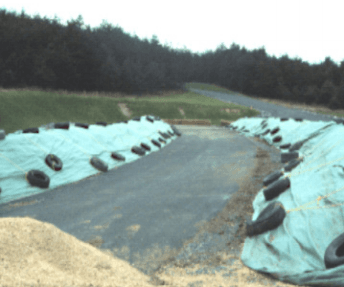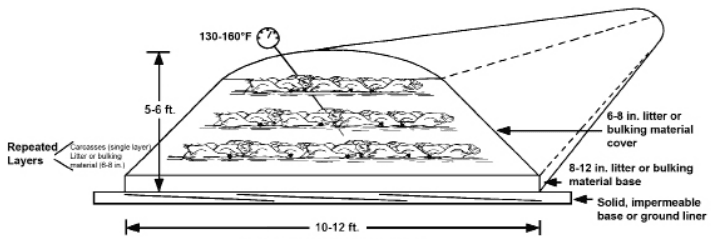Composting Mass Poultry Mortalities
Published: September 29, 2016
By: Casey W. Ritz / UGA Extension Poultry Scientist.
Introduction
Composting is a natural process where beneficial microorganisms decompose and transform organic materials into a useful and biologically stable end-product that is safe for the environment. This process has worked well for many poultry producers nationwide as a means of processing their daily poultry mortality.
Large volumes of poultry mortality have commonly been disposed of by means of burial. This practice, however, poses health and environmental risks from pathogens, particularly in areas prone to flooding or with a high water table. When substantial poultry mortality occurs due to disease, chemical residue or natural disaster, on-site composting of the carcasses will effectively process large mortality numbers into an environmentally stable product for land application.
Composting large volumes of dead birds requires a commitment to proper management in order for the process to be effective and successful. Proper siting of the windrow is necessary to facilitate composting and preventing nutrient runoff into surface waters.
Constructing the Windrow
If flock repopulation time schedules permit, forming windrows within the poultry house or litter shed is the ideal location for composting, with a level, firm base and protection from rainwater. If an under-roof site is not available, find a site that is well-drained, out of the flood plain, relatively free of rocks, accessible to machinery, and located away from areas of running or standing water. A temporary ground liner can prevent any potential leaching from the windrow. Bear in mind that the liner can cause difficulties with spreading equipment, as it will likely be torn during removal of the windrow. Temporary concrete barriers commonly used with highway construction projects or large hay bales have been successfully used to create a channel for compost containment. Protect open air piles from prolonged contact with rainwater with a covering that repels water, such as composting fleece or a plastic tarpaulin. Figure 1 illustrates the use of a composting fleece. A well-rounded windrow also will aid the shedding of rainwater.
Figure 1. Composting mortality windrows convered with a water-repelling compost fleece. If discarded tires are used to anchor the fleece in place, they should be cut in such a way that they do not retain rainwater.

Proper layering of the windrow is important for effective composting and helps ensure appropriate heating (Figure 2). Begin building the windrow with a base layer of poultry litter. This layer provides the foundation for the pile and helps prevent possible seepage. Additional litter, straw, sawdust or some other coarse carbon source is used as a bulking agent and is placed between layers of bird carcasses. This bulk material aids in aeration of the pile and helps provide an adequate supply of carbon. Poultry litter is convenient, inexpensive and serves this purpose well.
Each of the carcass layers should be only one bird deep. If the birds are carelessly loaded into the windrow, compost completion may be delayed and the carcasses may putrefy instead of decompose. Add sufficient water to the carcass layer to thoroughly wet the birds. It is unlikely that any additional water will be needed for the windrow if fresh poultry litter or damp carbon sources are used. Ideal moisture content will be 40-60 percent. Moisture levels either side of this range will delay and inhibit optimal composting action. Repeat the layering sequence until the recommended windrow height of 5 to 6 feet is reached. Once the layering is complete, top the windrow off with at least 8 inches of dry poultry litter, making sure that all carcasses are well covered. The carbon-to-nitrogen (C/N) ratio needed for windrow composting is the same as that needed for composting of daily mortalities, with a C/N ratio between 20:1 and 30:1 being ideal for this process. Maintaining the proper C/N ratio will facilitate the composting process. Since the C/N ratio plays a role in regulating the rate of biological activity within the pile, variations from this ratio will alter the composting process, leading to delayed, ineffective or malodorous composting. Windrows that have sawdust, straw and mortalities as the recipe ingredients have been shown to maintain high temperatures for longer periods of time compared to recipes that use strictly poultry litter as the carbon source (Murphy, et al., 1996). Poultry litter supplies both carbon and nitrogen to the recipe, which can lead to a nitrogen excess if litter is not used in sufficient quantity.
Figure 2. Windrow Cross Section.
Maintaining the Process
Rapid decomposition and maximum destruction of pathogens and pests are primary objectives with massive mortality situations. Reaching ideal composting temperature is important since temperature is the best indicator of proper biological activity. Monitoring windrow temperatures should become a priority and can be accomplished with a 36-inch probetype stainless steel dial thermometer. Ideally, the temperature of the compost will rise above 140 degrees F within 5 to 10 days as microbial activity progresses. If the compost fails to heat up or is malodorous, the material is probably too wet. This can be corrected by turning the windrow and adding more poultry litter or additional carbon material. Turning will restore the pore space and oxygen level within the windrow. If the temperature falls below 120 degrees F or rises above 180 degrees F, turn the windrow.
Allow at least 3 to 4 weeks for the initial compost cycle to work. The pasteurizing effects of time and temperature in the composting process will destroy pathogenic organisms that are present in the original organic materials.
Once the temperature peaks and then drops below 120 degrees F, turn the windrow for a second aeration and temperature rise. You may need to add more water to the compost at this time to maintain the 40-60 percent moisture content. A second heat cycle is essential to deactivate human and avian pathogenic organisms. Two or more aeration cycles may be required to completely cure, decontaminate and deodorize the windrow. Typically, however, after the second heat cycle, the composted material may be safely stored or land applied.
When managed properly, the compost process is an economical, biosecure and environmentally sound method of converting substantial poultry losses into a biologically stable product for use as a soil amendment. Approval must first be sought from the State Department of Agriculture before beginning the process of composting mass poultry mortalities. Additional information on composting mortalities can be obtained from your local cooperative extension office. Consult your poultry company before proceeding.
This article was originally published in University of Georgia Cooperative Extension Bulletin 1282.
References and Resources
Conner, D.E., J.P. Blake, J.O. Donald, and J.S. Kotrola. 1992. Composting Poultry Carcasses: Microbiological Safety. Proceedings of the 1992 National Poultry Waste Management Symposium, pp. 418-423.
Martin, J., D. Palmer, and L. Carr. 1996. Using Composting For Disposal Of Catastrophic Losses In Chickens. Extension Circular, University of Delaware.
Murphy, D.W., and L.E. Carr. 1990. Composting Dead Birds. FS 537. University of Maryland Cooperative Extension, College Park, Md.
Murphy, D.W. 1992. New Developments in Mortality Composters. Proceedings of the 1992 National Poultry Waste Management Symposium, pp. 33-40.
Poultry Water Quality Handbook. 1994. Poultry Water Quality Consortium, Chattanooga, Tenn.
Rynk, R., ed. 1992. On-Farm Composting Handbook. NRAES-54. Cooperative Extension, Northeast Regional Agricultural Engineering Service, Ithaca, N.Y.
Related topics
Authors:
Influencers who recommended :
Julián MeloJoin to be able to comment.
Once you join Engormix, you will be able to participate in all content and forums.
* Required information
Would you like to discuss another topic? Create a new post to engage with experts in the community.
Create a post5 de julio de 2017
We did composting of Broiler breeder moralities and did the same way almost you described in article. We found on completion of 5-6 weeks bones were still preasent in the compost and were not broken down. What you think how bones could be also converted to small particles and to be consumed during high temp. I found temp reached to 170 F max after 2 weeks. Please guide.











.jpg&w=3840&q=75)